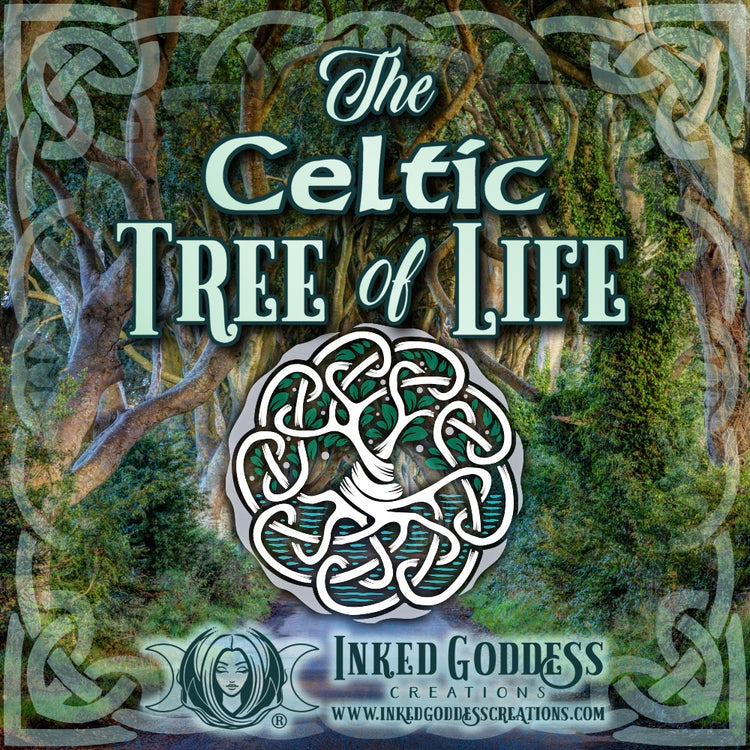The Celtic Tree of Life

As with many magickal traditions throughout human history, mystery and myth shroud the origins of the Celtic Tree of Life. Depending on who you ask, the Tree of Life was originally a Cedar, an Oak, an Ash, or a Hazel tree. Its significance is something that most scholars agree on, though. As we demystify the Celtic Tree of Life, we’re bringing you several stories and theories around this iconic symbol of life and death, and the worlds above and below.
Trees Were Central to Celtic Life
Called crann bethadh by early Celts, the Tree of Life is a symbol of harmony and balance. It appears in many traditional and modern designs, from tapestries and jewelry to architecture and beyond.
There are several reasons for the prevalence of this sacred symbol throughout Celtic traditions. Trees were of considerable significance to the lives of early Celts. Some researchers postulate that this ancient group of people were animists, believing that spirits reside in all living things. With this theory in mind, trees would have been one of the sacred parts of nature to these people.
Historians and archeologists have also found that different trees were used for specific purposes by the Celts. Some were used for building homes, others for weapons, and still other trees were used for the most mundane things like firewood. However, certain trees were considered truly holy and even revered as ancestors of humans. The Tree of Life is one of these sacred trees.
The Tree of Life represents the forces of nature that surround us. It also symbolizes the necessary balance between that which is above and things below. The branches grow wide and tall, while the roots push deep into the ground.
Was the Tree of Life a Cedar Tree?
Some believe that the original Tree of Life may have been a Cedar tree. Interestingly, Cedar oil was used by ancient Celts to preserve the heads of their enemies who were killed in battle. Perhaps the oil’s ability to preserve remains led people to associate the tree with the never-ending cycle of life.
According to other scholars, the ultimate Tree of Life was a tree that grew to be 26 miles tall, with branches that touched every star in the sky. Located in Uisneach, the spiritual center of Ireland, the Tree of Life may have originally been an Ash tree, which was sacred to the god Lugh.
Regardless, early Celts carried the tradition of the Tree of Life wherever they went. They honored the tradition by either leaving one tree standing in the middle of a cleared field or planting a new one in a clearing when a settlement relocated. The tree became the center of the village, around which all activity occurred. Under this sacred tree, families and friends gathered for significant events, appointed their leaders, and shared meals.
The Tree of Life was so revered that chopping it down was considered one of the worst crimes a person could commit. In fact, warring factions would capitalize on the tree’s importance by chopping down their enemy’s Tree of Life as a way of establishing dominance over the defeated army.
Other Trees of Significance
For the early Celts, the Oak was among the most sacred. Its name in Celtic was daur, and is the origin of the modern word “door.” It was believed that the Oak was a literal door to another world. Some of the earliest records of the Tree of Life date back to Neolithic carvings made around 2,000 BCE, and these carvings may depict Oak trees.
The Oak was the “King of Trees” for the Celts, who often crafted their magick wands from its branches. Acorns, which fall from the Oak tree, were used to increase fertility, and the Druids and Priestesses of the time used the sounds of rustling Oak leaves to divine messages from other worlds.
Legends surround trees from the ancient world. One of our favorites is the legend that if you fell asleep under specific trees, you could be transported to a fae land.
Other trees revered by the early Celts include the Willow, Rowan, Hawthorn, Elm, and Pine. Each tree was associated with different aspects of life: wishes, love and marriage, protection, healing, and more. We love this list of sacred trees provided on Wicca.com.
Celtic Tree of Life Knot
Perhaps one of the most recognizable depictions of the Celtic Tree of Life comes in the form of the Tree of Life Knot. It shows the branches of the tree reaching down to the roots, while the roots intertwine with the branches to create a circular, unending image. This continuous knot represents the revolving seasons and life cycles of all living beings.
No matter how it originated, the Celtic Tree of Life still stands today metaphorically and literally, should we choose to plant one in our own yard. It remains a symbol of unity with the earth, the natural cycle of life and death, and the connection we have with the divine.
Sources:
https://ireland-calling.com/tree-of-life/
https://irisharoundtheworld.com/celtic-tree-of-life/
https://www.shamrockgift.com/blog/tree-of-life-celtic-symbol/
https://wicca.com/celtic/sacred-trees.html
